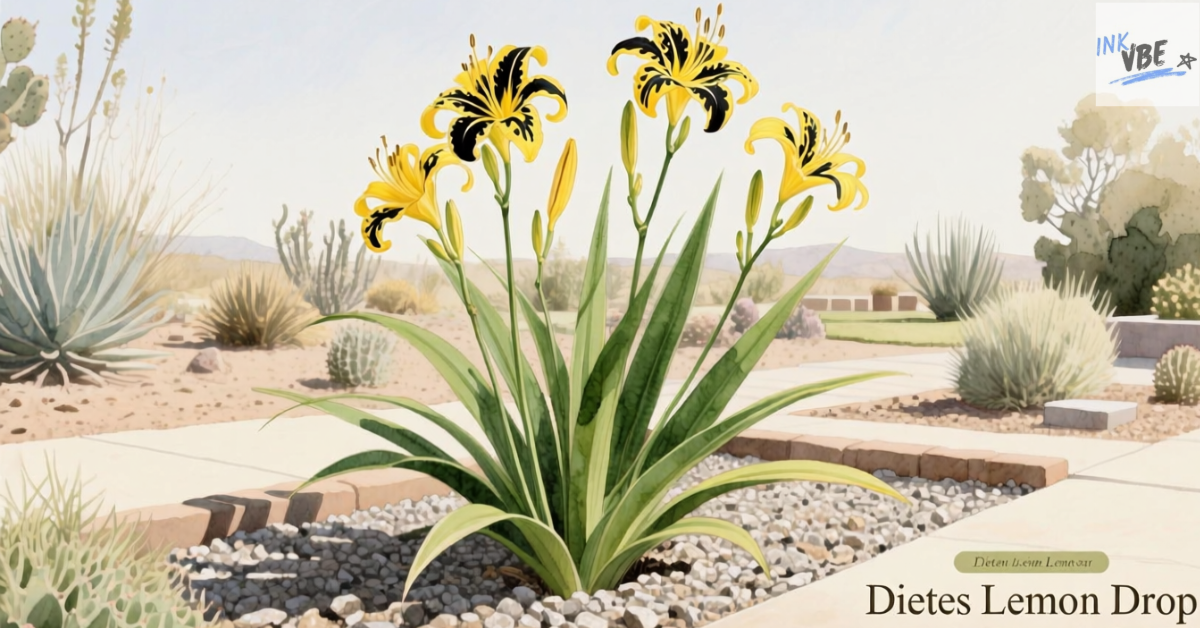Introduction
The Dietes Lemon Drop stands out as one of the most captivating perennial plants you can add to your garden landscape. This remarkable hybrid combines the elegant beauty of iris-like flowers with the durability that modern gardeners demand. Whether you’re a seasoned horticulturist or just beginning your gardening journey, this comprehensive guide will help you understand everything about this stunning plant.
Also known as the African Iris or Fortnight Lily, the Dietes Lemon Drop offers a perfect blend of ornamental appeal and low-maintenance care. Its distinctive cream-colored petals with bright yellow centers create a striking display that can transform any garden space. We’ll explore its unique characteristics, growing requirements, and the many reasons why this plant has become increasingly popular among landscape designers and home gardeners alike.
The Dietes Lemon Drop Plant
The Dietes Lemon Drop belongs to the iris family and represents a carefully developed hybrid that showcases the best traits of its parent plants. This evergreen perennial forms neat, compact clumps that typically reach 2-3 feet in both height and width. The plant’s architectural form makes it an excellent choice for contemporary garden designs and traditional landscapes alike.
What sets this variety apart from other Dietes species is its distinctive coloration and more manageable size. The flowers feature ivory white outer petals with vibrant yellow centers and subtle dark markings that add depth and visual interest. Each bloom lasts only a day, but the plant produces flowers continuously throughout its blooming season, ensuring constant color in your garden.
The sword-shaped foliage provides year-round structure and remains attractive even when the plant isn’t flowering. This characteristic makes Dietes Lemon Drop an excellent foundation plant that contributes to your garden’s design beyond just its flowering period.
Characteristics and Features
The Dietes Lemon Drop showcases several distinctive features that make it highly desirable for modern gardens. The plant produces flat, sword-like leaves that grow in fan-shaped clusters, creating an attractive fountain-like appearance. These leaves maintain their deep green color throughout the year, providing consistent visual appeal regardless of the season.
The flowering stalks emerge above the foliage, carrying multiple buds that open in succession. This sequential blooming pattern ensures extended flowering periods, typically lasting from late spring through early fall in ideal conditions. The flowers themselves measure approximately 3 inches across and feature a delicate, papery texture that adds elegance to any garden setting.
Notable Plant Characteristics:
- Size: Mature height of 2-3 feet with similar spread
- Foliage: Evergreen, sword-shaped leaves in deep green
- Flowers: Cream-white petals with bright yellow centers
- Bloom Time: Late spring through early fall
- Growth Habit: Clumping perennial with upright form
- Hardiness: Suitable for USDA zones 8-11
Growing Conditions and Requirements
Successfully cultivating Dietes Lemon Drop requires understanding its preferred growing conditions. This plant thrives in full sun to partial shade locations, though it produces the most abundant flowering when given at least 6 hours of direct sunlight daily. In extremely hot climates, some afternoon shade can help prevent stress and maintain flower quality.
The soil requirements are relatively flexible, but well-draining soil is essential for long-term health. Dietes Lemon Drop tolerates various soil types, including sandy, loamy, and slightly clay soils, as long as water doesn’t stand around the roots. The plant prefers slightly acidic to neutral soil pH levels ranging from 6.0 to 7.5.
Water requirements are moderate once established, making this plant an excellent choice for water-wise gardens. During the establishment period, consistent moisture helps develop a strong root system. Once mature, the plant demonstrates good drought tolerance while still benefiting from regular watering during extended dry periods.
| Growing Requirement | Optimal Conditions |
|---|---|
| Light | Full sun to partial shade (6+ hours direct sun) |
| Soil Type | Well-draining, sandy to loamy |
| pH Level | 6.0-7.5 (slightly acidic to neutral) |
| Water Needs | Moderate, drought tolerant when established |
| Temperature | Hardy in zones 8-11 |
| Humidity | Tolerates various humidity levels |
Planting and Establishment Guidelines
When planting Dietes Lemon Drop, timing and proper technique ensure successful establishment. The best planting times are during spring or fall when temperatures are moderate and natural rainfall can assist with initial watering needs. Choose a location that receives adequate sunlight while providing some protection from strong winds that might damage the flowering stalks.
Prepare the planting site by improving soil drainage if necessary. Dig a hole approximately twice the width of the root ball and only as deep as the container. This shallow planting prevents the crown from sitting too low, which can lead to rot issues. Backfill with native soil amended with compost to improve texture and fertility.
Space multiple plants 2-3 feet apart to allow for mature spread and good air circulation. This spacing prevents overcrowding while creating an attractive mass planting effect as the plants mature. Water thoroughly after planting and maintain consistent moisture for the first few weeks while the root system establishes.
Apply a 2-3 inch layer of organic mulch around the plants, keeping mulch several inches away from the plant crown. This mulching helps retain soil moisture, suppress weeds, and regulate soil temperature throughout the growing season.
Maintenance and Care Practices
Dietes Lemon Drop requires minimal maintenance once established, making it ideal for busy gardeners or those seeking low-maintenance landscapes. Regular watering during the growing season promotes healthy growth and abundant flowering, but avoid overwatering which can lead to root problems.
Deadheading spent flowers isn’t necessary for plant health, but removing the entire flower stalk once blooming finishes helps maintain a tidy appearance. Cut the stalks back to just above the foliage level using clean, sharp pruning shears to prevent disease transmission.
Annual fertilization in early spring with a balanced, slow-release fertilizer supports healthy growth and flowering. Apply according to package directions, typically using a 10-10-10 or similar balanced formulation. Avoid high-nitrogen fertilizers that promote excessive foliage growth at the expense of flowering.
Essential Care Tasks:
- Spring: Apply balanced fertilizer and fresh mulch
- Summer: Provide regular watering during hot, dry periods
- Fall: Remove spent flower stalks for winter tidiness
- Winter: Minimal care required in mild climates
- Year-round: Monitor for pests and diseases
Landscape Uses and Design Applications
The versatility of Dietes Lemon Drop makes it suitable for numerous landscape applications. Its upright, clumping growth habit works well as a border plant, accent specimen, or mass planting. The plant’s evergreen nature provides year-round structure, while its flowers add seasonal color and interest.
Container growing is another excellent option for Dietes Lemon Drop, particularly in colder climates where containers can be moved to protected locations during winter. Choose large containers with adequate drainage holes and use high-quality potting mix for best results.
The plant complements both formal and informal garden styles. In contemporary landscapes, its architectural form provides clean lines and structural interest. In cottage gardens or mixed borders, it blends beautifully with other perennials while maintaining its distinctive character.
Consider pairing Dietes Lemon Drop with plants that have contrasting textures or complementary colors. Ornamental grasses, lavender, or salvia create attractive combinations that highlight the unique qualities of each plant.
Common Pests and Disease Management
Dietes Lemon Drop enjoys relatively few pest and disease problems when grown in appropriate conditions. Good cultural practices including proper spacing, adequate drainage, and appropriate watering help prevent most issues before they become serious problems.
Occasionally, aphids or spider mites may appear during hot, dry weather. These pests typically don’t cause serious damage and can be managed with insecticidal soap or horticultural oil applications. Regular monitoring helps catch problems early when treatment is most effective.
Root rot can occur in poorly drained soils or with excessive watering. Symptoms include yellowing leaves and stunted growth. Prevention through proper planting site selection and watering practices is more effective than attempting to treat established rot problems.
Propagation and Division Techniques
Propagating Dietes Lemon Drop is straightforward through division of established clumps. The best time for division is during early spring before active growth begins or in fall after flowering concludes. Mature clumps naturally develop multiple growing points that can be separated into individual plants.
Carefully dig up the entire clump and use a sharp spade or knife to divide it into sections, ensuring each division has both roots and growing points. Plant divisions immediately at the same depth as the original plant and water thoroughly to encourage quick establishment.
Seed propagation is possible but more challenging and time-consuming. Seeds require specific conditions and may not produce plants identical to the parent plant due to the hybrid nature of Dietes Lemon Drop.
Seasonal Care Calendar
Understanding the seasonal needs of Dietes Lemon Drop helps ensure optimal performance throughout the year. Spring marks the beginning of active growth when fertilization and any necessary division should occur. This is also the ideal time to refresh mulch and assess winter damage.
Summer care focuses on adequate watering during hot, dry periods and monitoring for pest issues. Regular watering maintains flowering quality and prevents stress that could lead to health problems.
Fall signals the end of the active growing season in most climates. Remove spent flower stalks and reduce watering frequency as temperatures cool and growth slows.
Winter care varies by climate zone. In mild areas, minimal care is needed beyond occasional watering during extended dry periods. In borderline cold zones, mulching around the base can provide additional protection.
Troubleshooting Common Problems
Several common issues may affect Dietes Lemon Drop plants, but most are easily resolved with proper diagnosis and treatment. Poor flowering often results from insufficient sunlight, over-fertilization with high-nitrogen products, or overcrowding that restricts air circulation.
Yellowing leaves can indicate various problems including overwatering, underwatering, or natural aging of older foliage. Assess growing conditions and adjust care practices accordingly. Remove yellowed leaves at the base to maintain plant appearance.
Stunted growth typically suggests inadequate nutrients, poor soil drainage, or competition from weeds or other plants. Address these issues through proper fertilization, soil amendment, and weed control practices.
Conclusion
The Dietes Lemon Drop represents an excellent choice for gardeners seeking a beautiful, low-maintenance perennial that provides both structural interest and seasonal color. Its adaptability to various growing conditions, combined with minimal care requirements, makes it suitable for gardens ranging from formal landscapes to naturalized settings.
Success with Dietes Lemon Drop comes from understanding its basic needs and providing appropriate growing conditions. With proper planting, occasional watering, and minimal annual maintenance, this remarkable plant will reward you with years of reliable performance and stunning floral displays.
Consider adding Dietes Lemon Drop to your garden design whether you’re creating a new landscape or enhancing an existing one. Its unique combination of durability, beauty, and versatility makes it a valuable addition to any plant collection.
Read More: Fitness Modalities: Choosing the Right Workout for Your Goals
Frequently Asked Questions
Q: Can Dietes Lemon Drop survive freezing temperatures?
A: It’s hardy in USDA zones 8-11 but may suffer frost damage below 20°F. Container plants can be moved indoors in colder climates.
Q: How often should I divide established clumps?
A: Division every 3-4 years helps maintain vigor and prevents overcrowding, though it’s not strictly necessary for plant health.
Q: Will deer eat Dietes Lemon Drop plants?
A: Deer typically avoid this plant due to its tough, fibrous leaves and lack of preferred flavors, making it deer-resistant.
Q: Can I grow Dietes Lemon Drop indoors as a houseplant?
A: While possible, it performs best outdoors with natural light and air circulation. Indoor growing requires very bright conditions.
Q: How long do individual flowers last on the plant?
A: Each flower lasts only one day, but the plant produces new blooms continuously throughout the flowering season for extended color.





